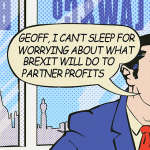The other day we were in a meeting with the head of strategy and marketing and the chair of an AmLaw 100 firm, and the chair mentioned an extremely promising introductory meeting he’d had a few days earlier with the General Counsel of a well-recognised company.
Although the GC and the chair had never met, the company already knew and respected this firm and used it from time to time for some specialised matters. What made the meeting so noteworthy was that the GC revealed they were planning some aggressive new initiatives and wanted a fresh and savvy outside law firm to help them navigate forward. Suddenly our AmLaw 100 firm seemed to have the inside track, with few if any alternatives on the GC’s shortlist.
So far so good, and a promising if not-yet-newsworthy episode. But then the chair related the back story of how the meeting came about, and we shifted abruptly into an alternate universe of unprofessional and just plain immature behaviour. I’ll explain at the end why I think this story carries the freight of meaning it does and isn’t just an addictive but bad-for-you episode of reality TV, Law Land version.
Groundwork for the meeting was laid when the company appointed a new CEO who was acquainted with a (good and reasonable) partner at our firm; partner reached out to the CEO who set up the meeting with the GC. Shortly before the meeting, the chair sent out an all-hands email letting people know about the pending meeting and asking if anyone knew anybody at the company.
Our offending partner—we’ll refer to him as Narcissus—piped up that the company was already ‘their client,’ that it was ‘proprietary to our group,’ and that holding the meeting was ill-advised because it could jeopardise that relationship. (This was the intermittent and specialised work I referred to above). Also, Narcissus couldn’t be responsible if the firm lost that work.
‘This is a perfect example of everything that’s wrong with this place!’ Our chair exploded at this point in recounting the tale. Those of you watching at home should feel free to embroider his language in your imagination; you run little risk of overshooting reality.
On how many levels is this wrong? My partner Janet Stanton, who was among many other things director, client relations, at Orrick before joining Adam Smith, Esq., has some thoughts. Then I’ll be back to wrap up this column and make good on my promise of putting this mind-bending story in a larger context. Over to Janet…
Where to start? – there are just so many violations of effective client management. That said, am I shocked? Can’t say that I am entirely. We all know that Narcissus’ attitude of ‘it’s MY client’ is rife throughout Law Land. In fairness, it’s also found in many other industries, as well. Many service professionals don’t want to ‘share’ their clients with others at their firm. So where does this attitude come from? Frankly, it doesn’t matter; it simply needs to be stopped in its tracks.
Especially in this case where we’re talking about:
• the Chair of the firm
• advancing the firm’s exposure at the client to the new CEO and GC for
• on-going and highly-remunerative work
This is cross-selling Nirvana.
Boatloads of research confirm that the (unsurprising) fundamentals of successfully nurturing current clients are:
• Increase the touchpoints at the client
• Get more partners at the firm meaningfully involved with the client
• Get more practice areas servicing the client
(On second thought, they must be surprising and unfamiliar to some.)
The other thing that struck me is that Narcissus felt entirely comfortable, nay entitled to voice umbrage. This requires severe attitude adjustment. Perhaps being sent to a re-education ‘camp.’
Seriously, this has to be addressed frontally and fast. Perhaps with an element of public shaming, the purpose of which is not (really) punitive but rather to make it crystal clear to the partners and the firm that this attitude and behaviour are completely unacceptable and will not be tolerated. Even if some continue to think this way (and some will), this action will give them pause next time a similar situation arises.
That’s called institutional learning. And more of this will better serve your clients, your lawyers and staff and, ultimately, your firm.
Now, back to Bruce….
From our perspective it was pure coincidence that this summer also saw publication in The New Yorker of Jill Lepore’s 6,000-word take-down of Clayton Christensen’s classic The Innovator’s Dilemma. But for driving home the value of the story of the firm Chair and the GC, it could not have come at a better time.
I won’t attempt to do justice to Lepore’s full-frontal assault on The Innovator’s Dilemma (I commend it to you, however), but if anyone ever wanted to launch a donnybrook over a classic business text, Lepore has given it her best shot. Consider just a few quick excerpts:
‘Most big ideas have loud critics. Not disruption. Disruptive innovation as the explanation for how change happens has been subject to little serious criticism… partly because disrupters ridicule doubters by charging them with fogyism [and partly because] innovation is the idea of progress jammed into a criticism-proof jack-in-the-box. [This era of disruption’s peaceable reign may be about to end with a bang—Bruce.]
Disruptive innovation as a theory of change is meant to serve both as a chronicle of the past (this has happened) and as a model for the future (it will keep happening). The strength of a prediction made from a model depends on the quality of the historical evidence and on the reliability of the methods used to gather and interpret it. Historical analysis proceeds from certain conditions regarding proof. None of these conditions have been met. [Broadside #1—Bruce.]
‘The Innovator’s Dilemma’ consists of a set of handpicked case studies, beginning with the disk-drive industry. “Nowhere in the history of business has there been an industry like disk drives” Christensen writes, which makes it a very odd choice for an investigation designed to create a model for understanding other industries. [The shiv is officially out—Bruce.]‘
I won’t spoil Lepore’s entertaining exegesis for you any further, nor are these the pages in which to pass final judgment on whether Christensen unearthed a timeless insight or whether it’s yet another hot air balloon rapidly running out of fuel.
Christensen fired back through the pages of BloombergBusinessweek:
‘Well, in the first two or three pages, it seems that her motivation is to try to rein in this almost random use of the word “disruption.” The word is used to justify whatever anybody—an entrepreneur or a college student—wants to do. And as I read that, I was delighted that somebody with her standing would join me in trying to bring discipline and understanding around a very useful theory. I’ve been trying to do it for 20 years.
And then in a stunning reversal, she starts instead to try to discredit Clay Christensen, in a really mean way. And mean is fine, but in order to discredit me, Jill had to break all of the rules of scholarship that she accused me of breaking—in just egregious ways, truly egregious ways.‘
Be that as it may, the concept and frankly the threat, are very much on every thinking lawyer’s mind these days.
My own view—and where the Lepore/Christensen bar fight may come to rest—reflects my own appreciation for the strength of both the disruptors from below and the entrenched from above.
As the FT put it in its Attack on Clayton Christensen’s theory falls wide of the mark:
‘The New Yorker article is a useful corrective for overzealous executives and consultants who took a 17-year-old idea and turned it into a religion. But complacent managers and smug strategists who think they can return to a golden age of known rivals and predictable markets should not take comfort from it.’
In other words, my view is that (a) innovators are the lifeblood of capitalism (thank you, Schumpeter) and also that (b) incumbents have real resources including capital, talent, and a client base. In other words, my hunch is that neither Lepore nor Christensen is right 100% of the time: Neither the Visigoths nor the Romans win every encounter: Usually, in fact, it depends.
One thing I will confidently predict, however: Disruption happens when the incumbents squander their resources.
Various are the ways incumbents can fail to rise to the occasion: Occasionally it’s through perverse and misguided management and decision-making, but far more often it’s through complacency: Preferring comfort to challenge, the familiar and well-trod channels to the bivouac into the uncharted, and drifting along in the soft well-known pleasantries over honestly and fearlessly confronting reality.
This brings us back to Narcissus. Whatever else Narcissus was (or wasn’t) thinking during this episode, those thoughts were not about the firm and its competitive position in the market. The thoughts were focused on what made one individual personally comfortable—and unconsciously (we’ll give them the benefit of the doubt) assuming they were in charge here.
We have news for all the Narcissus’s out there:
• Firm first and firm always;
• Your personal comfort zone, your customary preferences, and your cozy habits have nothing to do with anything anymore;
• And finally, the firm is not your oyster; you are neither King nor Queen.
Less than a year ago, Christensen wrote in Harvard Business Review that the Visigoths are on the horizon for management consulting and for law. Lepore might rebut that the Romans (that would be us) have hundreds of thousands of talented people and billions of dollars of revenue and profit.
We’re telling you that if you have too many Narcissus’s in your firm, our money is on the Visigoths.
Bruce MacEwen is the president of Adam Smith, Esq. You can read his blog here.











